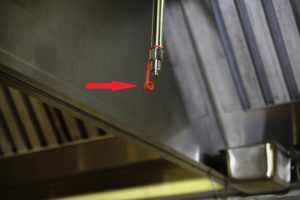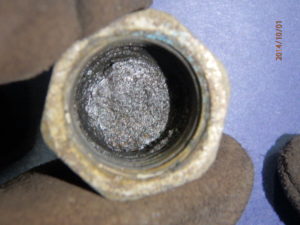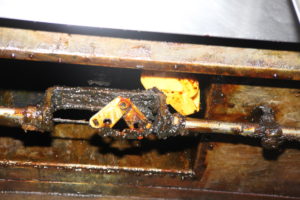

Figure 1 – Kitchen Fire
All image credits: Scott Futrell
This is the final in a series of articles that will summarize restaurant fire prevention. Don’t let your kitchen, restaurant, and livelihood end up like the one in Figure 1 above. Practice fire prevention!
Fire safety in your kitchen and your restaurant
The Minnesota State Fire Code provides the minimum requirements for the fire prevention and fire protection in eating and drinking establishments. It is up to you to reduce the odds of a fire impacting your business by routinely doing several things.
It is important that you monitor the work done by contractors hired to clean hoods, ducts, and fans as well as contractors hired to inspect, test, and maintain the fire suppression systems. The services they sell you may not match the objectives required to maintain your systems in a fire safe manner.
What do you need to do to protect your investment or your facility?
Look behind the filters and into the exhaust ductwork and monitor the grease buildup prior to scheduled cleaning as well as immediately after cleaning to ensure it is cleaner than shown in Figure 2 where grease and the cleaner’s flashlight remained the day after the professional cleaning. Keep in mind that solid-fuel burning appliances leave creosote and it is harder to clean, but easier to ignite.
Ensure that appliances are not moved or replaced from under existing nozzles or existing hoods without a consultant knowledgeable in the Minnesota State Fire Code, the International Mechanical Code, and National Fire Protection Association: NFPA 96, Standard for Ventilation Control and Fire Protection of Commercial Cooking Operations looking at the modifications.
Grease gets into the fire suppression nozzles if the caps are off and then when the system needs to operate it can’t flow agent out of the grease plugged nozzles, so a policy that includes ensuring the nozzle caps are always in place protects your investment. See Figure 3 for a nozzle with the cap off and for a nozzle with grease caked inside of it.


Figure 3 – Nozzle Missing Cap and Grease in Nozzle
Establish as a part of your training program the fire prevention and protection requirements for all kitchen employees. Manual pull station use (always the first thing in a fire if the system hasn’t operated automatically), always operating the exhaust system, cleaning to bare metal, nozzle caps in place, fire extinguisher training, and more. Then have weekly or monthly staff meetings to reinforce the fire prevention, fire protection, and cleaning requirements associated with grease-laden cooking.
ABOUT THE AUTHOR: Scott A. Futrell, PE, FSFPE, CFPS, SET, CFEI, is a fire protection consultant with Futrell Fire Consult & Design, Inc., in Osseo, Minnesota and has over 40 years’ experience designing, specifying, and investigating fire protection system related losses.

